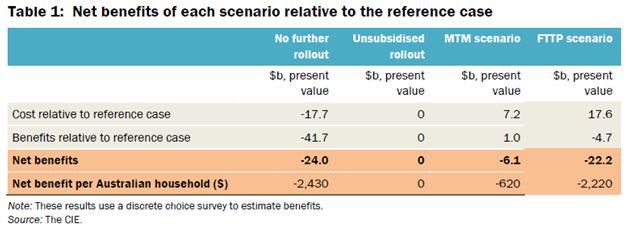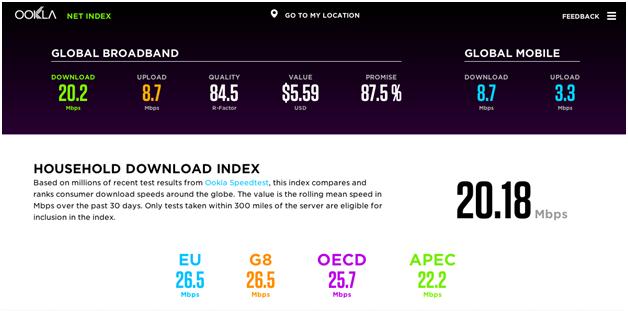
The National Bad-band Network
Last week, the Vertigan Panel published their second volume from their review of the National Broadband Network (NBN), and other options for upgrading Australia’s internet infrastructure. For those interested, you can find a copy here.
At Montgomery, what we find interesting is some of the assumptions that the Vertigan Panel modeling has been based on.
First, the report outlines the below chart which shows the costs of various options that the government could proceed with. The base case is ‘no further rollout’, which means the government would cease building the NBN completely.
Next, retail broadband service providers are permitted to roll-out their own NBN networks.
The third and forth scenarios are a multi-technology-mix (MTM) and fibre to the premises (FTTP) options respectively.
The conclusion from this chart is that the MTM strategy offers the most optimal mix of benefits to taxpayers at the lowest relative cost ($620 per Australian household. FTTP on the other hand can be delivered for a relative cost of $2,220 per Australian household). This is essentially the Vertigan Panel and the government’s main argument in supporting MTM as the means for which NBN Co. should base its NBN rollout on.
This analysis however assumes that by 2023, the average Australian household has a median demand for bandwidth of 15mbps.
Let’s think about that for a second. In 2004, general retail internet speeds were 256kbps, and well below 1mbps in built-up areas. That was then: ten years ago. Today, NBN Co, states that 58 per cent of households on the NBN are already paying for and obtaining speeds between 25 mbps and 100 mbps.
Given this trend, 15mbps seems a little antiquated for 2023, don’t you agree?
Another argument the report makes is that having a MTM network provides greater optionality since it can be upgraded later to FTTP in a relatively cost-effective manner (a projected 20 per cent saving). Notably, the report doesn’t appear to provide great deal of evidence to support this notion, which seems odd for such an important metric.
The report also recommends that these upgrades only take place in areas where it is economically viable for NBN Co. to do so (not exactly fair to rural Australia, where our cousins pay the same tax rates).
What I think the Government and its review panels are forgetting is that the benefits of the NBN don’t end with the monthly payment the retail service provider makes to NBN Co. on behalf of each user. As an example, public transport is well-known to be uncommercial despite ticket holder payments. However, we all know that the social and fiscal benefits provided by mobilising the population to work and generate taxable income is worth the direct losses.
To my mind, the same can be said of the NBN. It should be accepted as an uncommercial provision of infrastructure for a long-term social and fiscal benefit that far exceed the direct costs.
We are moving towards the Internet of Everything or, if you’ve been following the blog, the Internet of Almost Everything, and this will require world class infrastructure. The Australian economy, bereft as it is of any industry that can plausibly employ lots of people and export value-added products or services at the same time, also requires serious infrastructure. But what self-respecting entrepreneur is going to be keen to set up shop in a country with slower internet speeds than Madagascar? (No offense to Madagascar).
On a final note, if you compare the costs of the FTTN (fibre to the node) versus the FTTP rollout, the difference is about $16 billion (assuming that the FTTN rollout is completed by 2020). If their assumptions are correct, $16 billion sound rather small compared to the benefits it could deliver over the next 100 years.
When looking at a number like $16 billion (note: this would put the total cost of the FTTP NBN at over $40 billion spread out over 10-15 years) it’s also important to understand how large or small it is relative to the total spending of government.
With the following infographic (see fully functioning version here) one cannot help but think the Liberal Government are again displaying their economic rationalist – if not short-sighted – side. That’s to be expected of course; if you were hiring 28 cabinet members to run a country, you probably wouldn’t start out with 22 career politicians, 4 lawyers and a couple of people with some business experience.
This post was contributed by a representative of Montgomery Investment Management Pty Limited (AFSL No. 354564). The principal purpose of this post is to provide factual information and not provide financial product advice. Additionally, the information provided is not intended to provide any recommendation or opinion about any financial product. Any commentary and statements of opinion however may contain general advice only that is prepared without taking into account your personal objectives, financial circumstances or needs. Because of this, before acting on any of the information provided, you should always consider its appropriateness in light of your personal objectives, financial circumstances and needs and should consider seeking independent advice from a financial advisor if necessary before making any decisions. This post specifically excludes personal advice.
INVEST WITH MONTGOMERY


Roger – typo in your comment
Thanks for the quick eye, Guy
An excellent commentary Scott. Thanks. Always a risk when building new expensive infrastructure to build too small. The M5 tunnel in Sydney is but one example. With “time being money” the incremental speed is something that can be tangibly quantified. But the commonsense test for me is that I am not currently happy with my 9.1 mbps download – 15 mbps in 9 years time (2023) will be like reverting to the 56kbps dinosaur days…My data use is escalating exponentially – this may compound the frustration. btw I heard that some NBN speedtests almost “redline” on the tachometer…
Thanks for the comment Phil. If I might chime in, I do think the issue is not whether the present value of the social and future commercial benefits exceed the current cost (which I believe they do), but whether in 20 or 30 years our population will ask whether we made a wise decision investing the money in fibre to the premises. It might be reasonable to assume new technology, with much lower costs may render hard cabling redundant… much as the landline at home is now.
The problem is, at least according to our current understanding of physics, that optical fiber is the gold standard for communication. This is primarily due to the wavelength/frequency of light/electromagnetic radiation carrying the signal; laser light can’t be transmitted reliably through air like radiowaves, but radiowaves can’t carry the same amount of data that optical light can. I believe that the current world record for fastest download speed is around 110 terabytes per second, and I think something like 200 ‘channels’ down a single optical fibre, but the point is – it’s only through fibe that the next generation of data transmission advances will be made (short of a new, revolutionary field of physics being discovered).
Spot on Scott. If only politicians could explain the NBN in this rational and easy to understand way. The traditional or “old media” has a lot to lose from increasing internet speeds and will try to influence public opinion against the NBN. The general populous may buy this argument as it may be hard to understand why they need NBN speeds at this time even though they will need it in the (near) future.